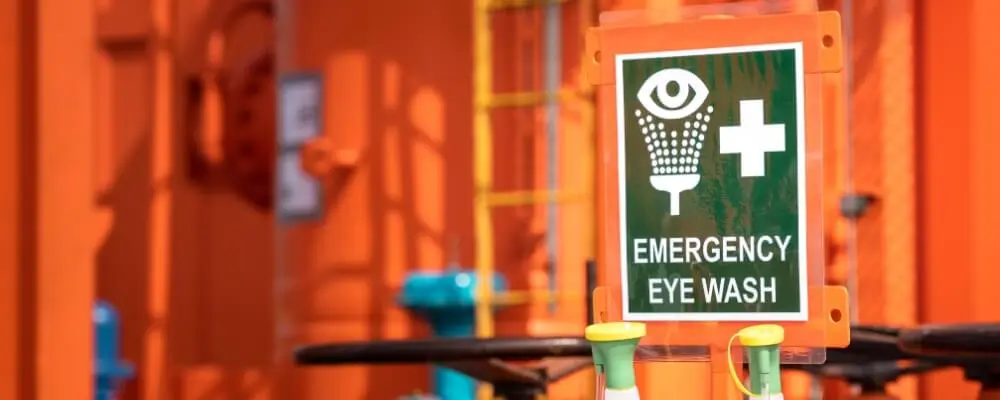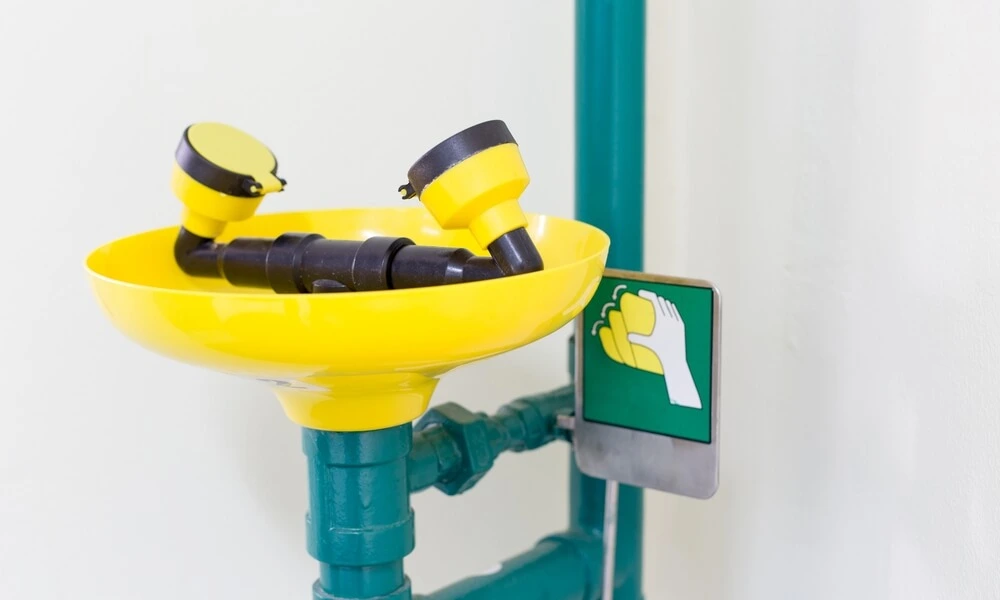In modern workplaces, where the use of chemicals and hazardous materials is commonplace, ensuring the safety of employees is paramount. Among the many safety measures, eyewash stations are a vital defense against ocular incidents. These stations are designed to offer immediate relief from accidental exposure to harmful substances. However, just having an eyewash station isn’t enough. It needs to adhere to specific standards to guarantee its efficacy during emergencies.
This blog delves deep into the 10 essential eyewash station requirements every workplace should implement. Whether you’re setting up a new facility or reviewing the safety protocols of an existing one, these guidelines will ensure you’re well-equipped to protect your employees’ vision.
10 Essential Eye Wash Station Requirements In The Workplace
Eye wash stations are critical in workplaces where workers are exposed to hazardous substances that might come into contact with their eyes. If chemicals or other hazardous materials enter an employee’s eyes, immediate and suitable eye flushing can prevent serious injury or permanent damage. Here are 10 essential requirements for eye wash stations in the workplace:

1. Location & Accessibility
Eyewash stations are critical in offering immediate relief after exposure to harmful chemicals or irritants. As such, their location within a facility is paramount. Placing them within 10 seconds or roughly 55 feet from hazardous material areas ensures that affected individuals can reach them promptly without wasting precious seconds. Moreover, easy accessibility is equally crucial.
If an employee’s vision is impaired due to an irritant, navigating around obstacles can be challenging, potentially causing further injury. Thus, having a clear, unobstructed path to the eyewash station is essential for rapid response and effective treatment.
2. Flow Rate
The water flow rate in eyewash stations is meticulously determined to offer maximum efficacy without causing additional injury. At a minimum, the station should deliver 0.4 gallons (1.5L) per minute, ensuring a robust flow to effectively rinse away contaminants. In situations where both the eyes and face might be exposed to harmful substances, combination units are employed. Given their dual purpose, these units necessitate a more substantial flow of at least 3 GPM. This ensures they can adequately wash both their eyes and face concurrently, offering comprehensive decontamination.
3. Duration
After exposure to hazardous materials, the affected areas should be flushed continuously for an optimal duration to ensure all contaminants are washed away. A continuous flow of water for at least 15 minutes is recommended. This duration is based on the time typically required to neutralize most acids and alkalis, two common substances that might necessitate an eyewash station. A shorter duration might not be sufficient to remove these contaminants fully, leading to prolonged exposure and potential harm.
4. Water Quality & Temperature
Water quality plays a pivotal role in the effectiveness of the eyewash process. Using contaminated water could introduce new irritants or pathogens, exacerbating the injury. Therefore, ensuring that the water is clean is of utmost importance. The water’s temperature also influences the treatment’s efficacy and comfort.
Tepid water, which is lukewarm and falls between 60 and 100 degrees Fahrenheit, offers optimal conditions. Water that’s too cold can cause discomfort and discourage individuals from flushing for the recommended duration, while water that’s too hot can cause burns or exacerbate the injury.

5. Simultaneous Flushing
Being closely situated, the human eyes often experience simultaneous exposure to harmful substances. As such, eyewash stations are designed to flush both eyes simultaneously. This ensures that both eyes receive immediate attention and maintains a consistent cleansing process. Additionally, the force with which the water is delivered is balanced to be strong enough to wash away contaminants effectively but gentle enough not to cause harm to sensitive eye tissues. Proper design and calibration ensure that the eyes can be thoroughly cleansed without causing additional injury.
6. Nozzle Design & Protection
The design of the nozzles in an eyewash station is fundamental to its utility and effectiveness. They must be shaped and angled so that a user, even when distressed and in pain, can intuitively lean into the stream of water and hold their eyelids open with their hands. This ensures maximum eye exposure to the flushing solution and the most effective removal of contaminants.
Moreover, the environment in which the eyewash station is placed might have airborne contaminants or be susceptible to extreme weather conditions. Therefore, these nozzles must be protected with airtight covers. This not only prevents potential contamination from dust, chemicals, or other airborne particles but, in colder climates, also ensures that the water does not freeze within the nozzle, making the station unusable in times of emergency.
7. Maintenance & Inspection
The consistent functioning of an eyewash station is non-negotiable, given its emergency nature. To ensure this, it is crucial to activate the station weekly. This confirms its working condition and helps flush out stagnant water, preventing bacterial growth or mineral build-up. Besides routine checks, a comprehensive annual inspection is indispensable. This is a procedural requisite and a necessary measure to ascertain compliance with established safety standards. Such thorough checks can help preempt potential issues and ensure that the station is always ready for use.
8. Clear Signage
In emergencies, every second counts. Hence, the visibility and clarity of signage indicating the location of the eyewash station becomes paramount. These signs should be unmistakable and guide workers directly to the station without any confusion.
In addition to the signage, the surrounding area where the station is situated should be well-lit. If someone has been exposed to a harmful substance, their vision may be compromised. Ensuring adequate lighting facilitates quicker and safer access to the eyewash station during these critical moments.

9. Training
While having an eyewash station is essential, its effectiveness is significantly diminished if employees are unsure of its proper usage. Regular training sessions should be conducted to instruct employees on the correct eyewash station procedure.
Emphasis should be placed on keeping the eyes open during flushing to ensure contaminants are thoroughly rinsed away. Such training ensures that the station is used effectively during emergencies and reinforces the importance of eye safety in the workplace.
10. Documentation & Reporting
To maintain the highest standards of safety and functionality, it’s essential to document every interaction with the eyewash station. This includes routine inspections, activations, maintenance tasks, and any incidents where the station was deployed. This documentation serves as a record to track the station’s performance and note any recurrent issues.
Additionally, having a well-defined protocol for reporting ensures that any malfunctions, inefficiencies, or areas of improvement are promptly addressed. This systematic approach ensures the equipment’s longevity and upholds the facility’s safety standards.
Conclusion
Ensuring eyewash stations meet the highest standards in an era where workplace safety is more crucial than ever is non-negotiable. While often overlooked, these stations play a pivotal role in preventing lasting ocular damage during emergencies. By adhering to the ten essential requirements detailed in this article, employers showcase their commitment to employee well-being and establish a robust line of defense against unforeseen incidents.
As we navigate an ever-evolving industrial landscape with its unique challenges, let these guidelines serve as a steadfast reminder of the importance of preparedness and proactive safety measures. Your employees’ vision is invaluable; safeguarding it should always be a top priority.

